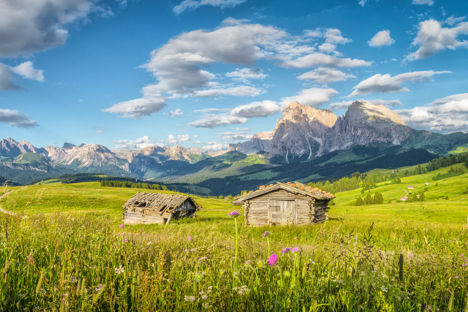
The complete foodie guide to Trentino-Alto Adige
With Veneto and Lombardy to the south, Austria to the north and the glorious Dolomites sawing through the middle, Trentino-Alto-Adige is one of Italy’s most striking regions, with a unique food scene to match.
The complete foodie guide to Trentino-Alto Adige
With Veneto and Lombardy to the south, Austria to the north and the glorious Dolomites sawing through the middle, Trentino-Alto-Adige is one of Italy’s most striking regions, with a unique food scene to match.
Like many of Italy’s border regions, Trentino-Alto Adige (also known as Trentino-South Tyrol) hasn’t always been part of Italy. This mountainous region belonged to the Austro-Hungarian Empire for many years, and then Austria, until it became Italian as part of the post-World War One Treaty of Saint Germain. Though technically still part of Italy, Trentino is a self-governing province these days, and it feels equal parts Italian and Germanic.
Trentino’s history explains its cultural dynamism. Residents here frequently speak Italian and German (as well as the local Ladin dialect), and you’ll often find town names, road signs and menus written in both languages. The striking Dolomites (or Pale Mountains as they are also known) make Trentino hugely popular with outdoorsy tourists, who come in the summer to enjoy hikes in the foothills, and in the winter for skiing and alpine sports. As a result, this is a part of Italy that does hospitality extremely well – hotels and restaurants are held to very high standards.
The same goes for the food – Trentino has an exceptional gastronomic reputation, in part because of the high benchmark for quality, but also because this is a region that produces something very unique. If you come here expecting classic Italian fare you may be disappointed, but food tourists with a slightly open mind will be amazed at Trentino’s distinct gastronomy. Italian and Germanic heritage sits side by side on menus – rich stews come with polenta, dumplings and filled pasta are interchangeable in hearty broths, and pasta often comes in the form of spätzle – a fresh egg pasta with medieval German origins.
The alpine plains are home to a unique ecosystem and a wide spectrum of unusual fruits, vegetables, herbs, wild flowers and more. This is all reflected in the region’s cuisine, and nowhere is that more evident than in the hallowed halls of St. Hubertus – Norbert Niederkofler’s celebrated three-Michelin-starred restaurant that sits in the shadow of the Fanes-Sennes-Prags Nature Reserve. Norbert makes full use of the ecosystem around him to create dishes that could not exist anywhere else in the world, proving that Trentino-Alto Adige is one of the brightest jewels in Italy’s gastronomic crown. Read on for a better understanding of the local flavours, ingredients and dishes that make it a must-visit (whether you’re into skiing or not).
Ingredients and flavours
Trentino-Alto-Adige boasts some of the best pastures anywhere in Italy; cows and sheep graze happily on the region’s indigenous herbs and wild flowers, and that reflects in the quality of dairy in the alpine peaks of the Dolomites. The region is home to over 200 different types of cheese, making this an essential destination for cheese connoisseurs. Many of those are unique to Italy’s most northerly province – specialities include the soft and briny Stilfser, fruity Vinschger and Alta Badia, which resembles nutty Swiss cheeses like Gruyere.
Pasta is popular in Trentino, but perhaps not quite as you know it. Filled pasta dishes like casunziei – beetroot-stuffed ravioli with poppy seeds – and schlutzkrapfen – half-moon parcels with spinach and ricotta – are very traditional, as is spätzle – a free-form egg pasta that is common all over Germany, Austria and Switzerland.
Dumplings are a big deal in Trentino. They come in all sorts of shapes, sizes and flavours – strangolapreti, for example, are gnocchi-esque, made with potato and flour and flavoured with spinach and cheese. Canederli are one of Trentino’s most famous regional specialities – these are bread dumplings in a more northern European style, and often served in a rich beefy broth. Though dumpling recipes are more specific these days, they really have their roots in the poorest kitchens, where stale bread would be repurposed with other ingredients to create a satisfying meal.
Perhaps influenced by their Germanic roots, Trentino locals are often heavy meat-eaters. The quality of grazing in the mountains makes meat here particularly good quality too – beef and lamb often end up in hearty soups and stews, served on silky beds of polenta, or with barley. Sausages are also very popular, and served with sauerkraut (as is traditional further north across the border).
Trentino-Alto-Adige is also the home of speck – one of Italy’s most famous salumi. Hams are boned out, rubbed with a cure of bay and juniper, then smoked and aged, giving speck a deeper, more robust flavour than more delicate prosciutto from the likes of Parma and San Daniele. It’s often served with rye bread, crackers or a selection of cheeses, and is incorporated into many of the local soups and dumplings.
Trentino is far from the traditional heartland of Italian wine country, but winemakers here have been tending vineyards on the mountain slopes for thousands of years. In fact, South Tyrol has three indigenous grape varieties – Schiava, Lagrein and Gewürztraminer – the latter of which we usually associate with Germany. Many of the best white wines here have a clean, refreshing minerality that reflects the bracing nature of the terroir, but Schiava and Lagrein are both red grape varieties, and Pinot Noir also grows well here. Ninety-nine percent of the wines made in South Tyrol are made under a DOC classification – the highest percentage in all of Italy. Ninety-nine percent of the wines made in South Tyrol are made under a DOC classification – the highest percentage in all of Italy.
You’ll see more traditional Austrian desserts commonly all over Trentino, particularly in the north. Apfelküchel, for example, is a delicious apple cake that proves to be very popular, and classics like strudel and sachertorte are much the same as their counterparts north of the border. Dumplings come sweet as well as savoury – keep an eye out for canederli con albicocche (also known as marillenknodel), where gnocchi-like dumplings come with a sweet apricot filling. Last but not least, tasty krapfen – essentially Trentino’s take on a doughnut – are available all year round with a variety of sweet, jammy fillings.
Famous dishes
Canederli started life as a simple way to use up stale bread and put a filling meal on the table. They’re often flavoured with typical alpine ingredients like cheese, speck and wild herbs, but you can feasibly put anything you like into your canederli, which often come served in a rich beef broth.
The unusual name of these dumplings translates as ‘priest stranglers’ – a reference to a myth that a priest once ate these dumplings so fast that he accidentally choked on them. While we don’t know if that’s true (indeed, that same story is told about a pasta shape called strozzapreti further south) they’re certainly delicious – these bright green dumplings are packed with spinach and often served in a meaty broth, similar to canederli, or doused in brown butter.
These handmade egg noodles are common in Germany, Austria and Switzerland, and have found their way into Italian culinary parlance in Trentino-Alto Adige. An egg pasta dough is pushed through a colander or something similarly hole-ridden, creating small almost spherical noodles which cook quickly in boiling water. You’ll find spätzle served in all sorts of different ways, but this cream sauce and speck version is typical of South Tyrol.
These dainty spinach and ricotta-stuffed half-moons are served in a classic Italian way – with plenty of brown butter and a dusting of Parmesan.
Hearty and comforting, this barley soup can easily be made with whatever leftover vegetables you have in your fridge. Our version is spiked with pancetta too, for a lovely smoky salinity.
Boznersauce is a hard-boiled hollandaise of sorts, typical of Bolzano (the town is called Bozen in German, hence the name of the sauce). The eggs are boiled first, then the yolks removed and used to make a sauce, which is finished with chopped egg white. Asparagus grows wild all over Trentino in spring, but you can serve this sauce with anything in place of a hollandaise.
Sweet beetroot and creamy ricotta make delicious partners inside these classic mezzelune, but it’s the sprinkling of poppy seeds that gives these ravioli a distinctly northern touch.

